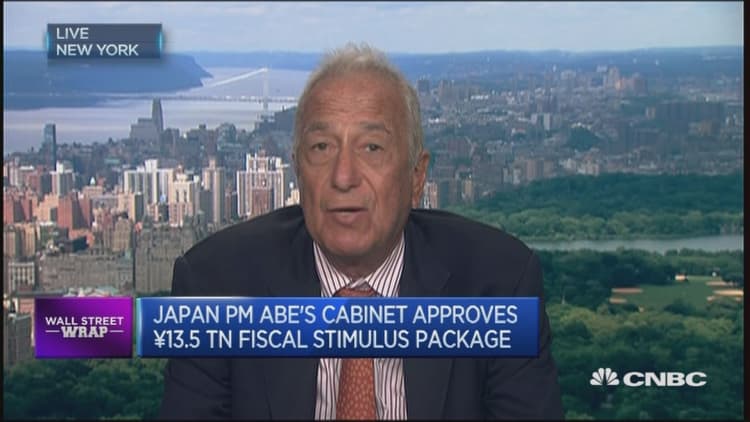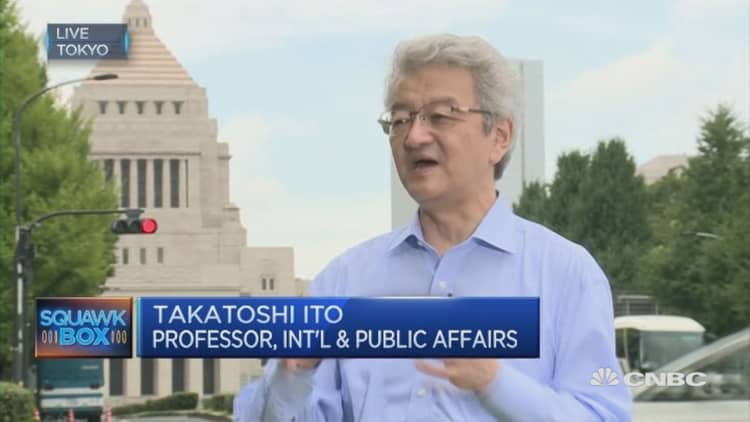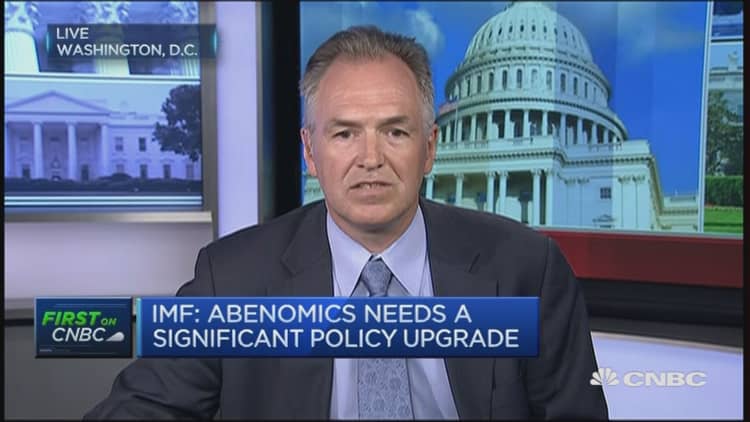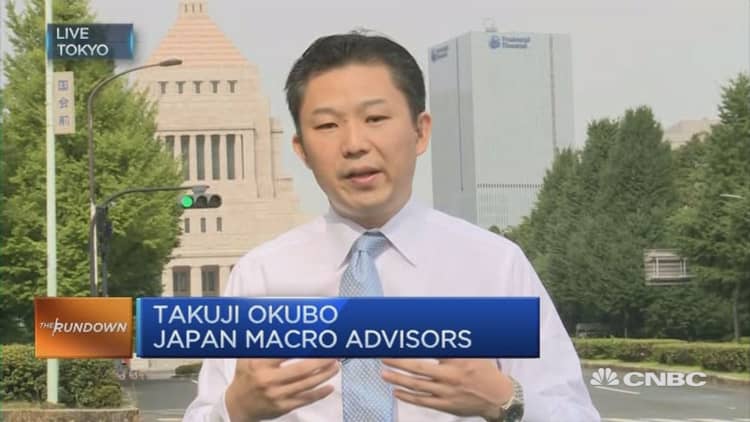



Japan's government spending plan has been panned as just not big enough, but it may have already had one big effect: Pushing deeply negative bond yields toward the zero line.
Jim Awad, managing director at wealth advisory firm Plimsoll Mark Capital, said that Japan's move to fiscal spending instead of further action from the central bank may have spurred the view that monetary policy had reached the limits of its effectiveness.
"It is the aggressive monetary policy worldwide which has sent stock prices up and bond yields down. So the fact that they switched from more aggressive monetary policy to fiscal, I think, sort of spooked markets worldwide," he told CNBC's "The Rundown."
"I think the markets felt that if they were going to go the fiscal route as opposed to the monetary route, they didn't do enough and therefore it's likely to fail," he added.
Japan government bond (JGB) yields have climbed, with the benchmark 10-year yield rising from as low as negative 0.273 percent shortly before the Bank of Japan (BOJ) announcement, to within a smidgen of the zero line, touching negative 0.009 percent on Tuesday. Bond prices move inversely to yields.
That spurred rises in other government bond yields, analysts said. On Tuesday, was yielding negative 0.033 percent, up from negative 0.124 percent Friday.
"Elevated JGB volatility historically is contagious and this time is no different," said Tim Condon, head of research for Asia at ING Financial Markets, in a note Wednesday.
On Tuesday, Prime Minister Shinzo Abe's cabinet approved a $274 billion stimulus package, which included cash payments to those with lower income, adding more workers to pension programs, college scholarships and fresh infrastructure projects.

Analysts said the package simply wasn't large enough to spur a surge in economic growth, offering markets a second disappointment after additional easing from the BOJ last week fell short of expectations. The BOJ did not increase purchases of government bonds as had been widely expected, likely disappointing those market players who had hoped to sell more bonds to the central bank for a profit.
Even the Abe government wasn't expecting too much bang for the yen, projecting the package would add only around 1.3 percentage points to gross domestic product (GDP) growth near-term.
The details of the package increased expectations that the BOJ's quantitative easing program, through which the central bank purchases assets including exchange-traded funds (ETFs) and JGBs, "had run its course and stimulus now would be exclusively in the form of bridges to nowhere," ING's Condon said.
Another factor was set to push up bond yields, at least in Japan: Supply appeared likely to surge. Reuters reported on Tuesday, citing sources, that the government would be issuing several hundred billion yen worth of 40-year bonds as soon as September.
But Awad said he expected the rise in yields wouldn't last long.
"I think that investors will conclude that what the Japanese are doing fiscally won't work. It hasn't worked in the past and it's not enough to work now," he said, adding that growth would remain slow. "I'm not afraid of the yields. I think the yields will go back down worldwide."
Condon also expected that yields wouldn't stay elevated for long.
"We consider the pain from the current spike a buying opportunity because low expectations for Japanese financial policy to 'work' will quickly be filled," he said.
Not everyone was convinced the reboot of Abe's economic plan, which has been dubbed Abenomics, would fail.
Abenomics was introduced in 2013 in an effort to break Japan's economy out of a decades-long deflationary spiral. The program, which was expected to include three "arrows," began with a first arrow of massive quantitative easing from the BOJ.
It was followed by plans for increased government spending. But the third arrow of structural reforms, including immigration and labor changes, has disappointed expectations.
Luc Everaert, the mission chief for Japan at the IMF, told CNBC's "Squawk Box" that he expected that coordinated fiscal, monetary and structural policies would likely boost growth.
"For this all to work together, we're looking for a package of all the arrows. We need to push for wages and labor market reform. We need to have a fiscal stimulus at least in the short term to keep wages and price pressures up and monetary policy has to stay very accommodative," he said.
"In the context of additional structural reforms, which could be forthcoming in the fall, maybe the Bank of Japan could also step up its easing policy. It still has a space available to do so and I think it needs to continue to commit to reaching its inflation target of 2 percent over the medium term."
Academics also were on board with the government's plan.
"They expected too much. For economic theory, this is the right number," Takatoshi Ito, a professor of international and public affairs at Columbia University, told CNBC's "Squawk Box."
Jun Saito, a senior research fellow at the Japan Center for Economic Research and a special adviser to the cabinet office for economic policy, largely agreed.
Saito told "Squawk Box" that the government was striking a "pretty good" balance between fiscal stimulus and concerns about the country's already high debt levels.
He noted that Abe has proceeded with some structural reforms, such as liberalizing the retail electricity market and cutting the corporate tax rate, but labor and financial market reforms would be important ahead.
But Saito added that it wasn't clear whether the plan would meet, exceed or fall short of the projected 1.3 percentage point growth boost: "It depends on the reaction of the private sector," he said.
Follow CNBC International on Twitter and Facebook.
—By CNBC.Com's Leslie Shaffer; Follow her on Twitter @LeslieShaffer1


